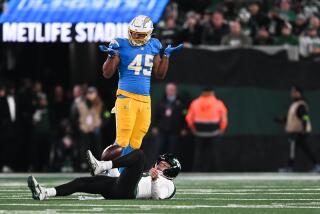MIXED BLESSINGS : Recovery From Rare Disease Affords LeBel Time to Hone Skills for NFL Job
- Share via
There can’t be many players in the National Football League who owe their careers to Osgood-Schlatter disease.
The rare, painful bone ailment--which usually afflicts teen-agers in the knees--kept Harper LeBel on the sidelines during his first two years at Notre Dame High. It was during that time that he mastered the art of rifling a football between his legs. Working as a team manager to stay close to the sport, LeBel was asked to snap the ball to the punter in practice. Every day. In two years, he developed pinpoint accuracy and exceptional pace on the ball.
Were he not afflicted with the disease, LeBel (6-feet-4, 240 pounds) would have been off practicing with the tight ends. Even if his snapping talent had been discovered much earlier, it is doubtful that he would have been given the time needed to hone his technique.
“I learned by doing it over and over,” he says.
Given the green light to play as a junior, LeBel went on to perform well enough at tight end to earn a scholarship to Colorado State. He started at tight end for the Rams and also snapped on punts and field goals. Much to his surprise, the Kansas City Chiefs selected him in the 12th round of the 1985 draft. As a center.
“It was a strange idea to me, but I was just glad to be selected,” LeBel says.
But almost as soon as LeBel realized that his speciality could earn him a living, the Chiefs cut him in training camp. It has taken him four more years--and several other disappointments--to finally catch on with an NFL team. He recently survived the final cut with the Seattle Seahawks, making their 47-man roster as the No. 1 long-snapper and all-round member of the special teams.
“It’s been kind of a long road,” says LeBel, whose family lives in Sherman Oaks. “There were many times I thought I’d never play again.”
But tenacity comes easily to someone who has the moxie to overcome Osgood-Schlatter disease. After staying out of football in ’86 to finish his degree in business marketing, LeBel took advantage of the ’87 NFL Players Assn. strike, signing with the San Diego Chargers after quitting his job as an assistant dock foreman. A month later, the strike was over, and so was LeBel’s football career.
At least, temporarily.
A year ago, LeBel wrangled a free-agent contract with the Dallas Cowboys but was cut in training camp. Then he was flown to Tampa Bay for a tryout with the Buccaneers but returned a week later after being cut.
Cross off another season.
He spent ’88 working as a security guard at Gladstone’s, a bar and grill in Malibu, and as a volunteer assistant football coach at Notre Dame High. He waited impatiently for the ’89 season, knowing that a business career was being put on hold.
“There were times I wasn’t sure if I should stick it out,” he says.
LeBel’s agent, Frank Bauer of Stockton, tried shopping LeBel around during the off-season but was unsuccessful.
In the last week of July, with training camps already under way, LeBel was worried that he would miss another NFL season. That night at Gladstone’s, he said a prayer. The next Friday, his mother called him at work and said that Seahawks assistant general manager Chuck Allen had phoned. The Seahawks were looking for a long-snapper.
LeBel played well during the exhibition season, and he had to. A lot of players can snap a football. The trick is to hit the target 15 yards away every time; a bad snap can turn a game around. LeBel’s snaps were on the money to punter Ruben Rodriguez, and he also made four tackles on special teams. During the season, he will do the snapping on punts, back up center Grant Feasel on field-goal and point-after attempts, block on the kickoff-return team and in short-yardage situations, and work as the third-string tight end in practice.
“ Pleased doesn’t describe how I feel,” LeBel says. “Football always stayed in my heart. I knew I would get my break.”
More to Read
Go beyond the scoreboard
Get the latest on L.A.'s teams in the daily Sports Report newsletter.
You may occasionally receive promotional content from the Los Angeles Times.










